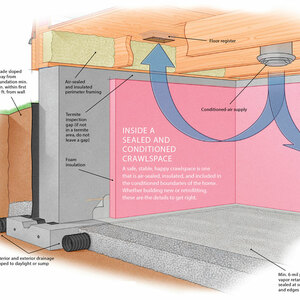Venting cathedral ceiling rafter bays
I am constructing a 40′ x 60′ wood shop with an apartment pushed up into a 9 in 12 roof above. The location is western North Carolina in the mountains (@ 3100′). 90% of the apartment has a cathedral ceiling, framed w/ 2 x 12 rafters.
I’ve been wrestling with insulation and whether to vent the rafter bays. My current bent is to vent the bays to avoid problems with the BI and use foam (either Corbond or Icy) to insulate. I plan to provide a vent channel with furring strips and either polyiso foam board or 1/4″ plywood. I’m not trying to prevent heat buildup in the roof, but rather provide a means of drying the sheathing and roof from the underside.
My specific problem is perforating the blocking that obstructs each rafter bay. The NC code addendum to the IRC specifies that the free ventilation are should be at least 1/300 of the area to be vented (the rafter bay). Since my rafter bays are 25′ long (not including the overhang) this requirement means 24 square inches of free vent area. That’s equivalent to 14 1-1/2″ holes in the blocking, which requires more than the 1-1/2″ to 2″ I would hope to allow for the vent channel. To boot, typical continuous soffit vents and ridge vents only allow 9 square inches of free area per linear foot (ie 18 square inches per rafter bay instead of 24).
Can anyone help me get my feet back on the ground?


















Replies
As to your basic quandary of the free vent area, I can't advise you. Here, they spec a minimum distance between insulation and sheathing, for cathedral ceilings, and as long as you meet that number the BIs are happy. Whether you obtain it by furring out the top of the rafters or by using deeper rafters isn't important to them. I doubt they'll fuss over the number of square inches of soffit vent per lineal foot you get if you use continuous soffit venting along the whole length, but then again perhaps the BIs in your area are hard-@sses about stuff like that- I have no idea.
A word of warning though: squirrels are little b@stard things, so you should be sure not to install your foam insulation until your soffits and fascia are in place if there are squirrels around. Otherwise, you're asking for what happened to me to happen to you too, and I guarantee you won't like it! I didn't want to install soffits and fascia until I did my siding, so the addition spent the winter wearing nothing but Typar- all of which made it through the winter just fine. But since I wanted to work in reasonable comfort, I got my blocking and 1" EPS foam baffles and ceiling wiring in place and then had the place sprayed with Icynene. The "rats with PR" climbed in via the missing soffits right away and made themselves at home in the vent space, chewing through the EPS foam baffles I'd used and tearing the hell out of my Icynene in several places to make nests. Nothing short of lethal force deterred them- not mothballs, not Critter Ridder, not the ultrasonic dealie, and forget about trapping them- they're far too wiley. Got right out of the Hav-A-Heart trap literally within minutes of getting in. It'll be many, many cans of spray foam to fix their damage!
They may not chew through new 1/4" plywood, but I've seen them chew through 3/4" PT so I wouldn't count on it. They will go through your foam panels even if they've got a foil facing on them. Don't risk it!
Personally, if I had it to do again, I'd go with dense-packed cellulose. Though the Icynene definitely seals up gaps and blocks air movement extremely well, it was very expensive. Worse still, it was mis-installed in my garage/workshop, leaving an odour which persists now, even five months after the installation was completed. The odour is detectable even through the 6 mil poly vapour barrier. If the risk of this problem was known to me up front, there's no way I would have chosen this product, and nothing short of a lawsuit is going to get me redress from the installer.
dense-packed cellulose. What is that? Does it come in bats, is it foam, is it that loose stuff?
Do a search here and you'll learn lots. Also have a look at Mike Smith's Adverse Posession house thread- he's doing it there and is documenting the whole process.
Basically you install a non-woven fabric mesh material over the joists or studs, cut holes into each bay and use a blower to blow in chopped cellulose- the same stuff you use for loose-blown cellulose in attics- until its density is greater than its settled density. No danger of it settling further then. It's a great draft stop, very good R value, non-toxic and no chance of residual odour as with my Icynene mis-installation. It's also way cheaper than Icynene, much less Corbond or other 2lb closed-cell foams.
Thanks, that is what I thought it was. How does the R value compare to FG?
In static terms, the R value of cellulose is about the same as FG. But in real wall performance, it's better than FG due to its tendency to reduce air infiltration. It's also got a more stable R with respect to inside/outside temperature difference, due to its ability to eliminate internal airspaces within walls which can set up convection currents and defeat R value. That problem happens a lot with real installations of batt insulation. Just say no to FG. If you must do batts, at least use mineral fibre instead- much denser and less likely to permit air circulation within the batts themselves.